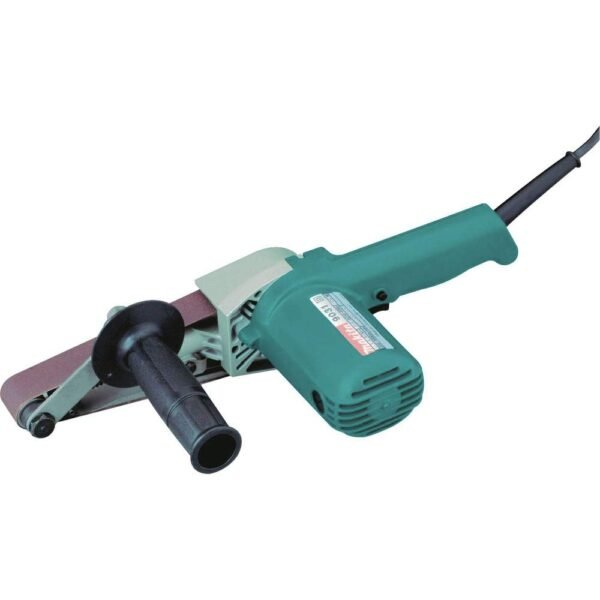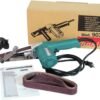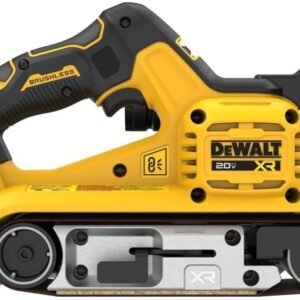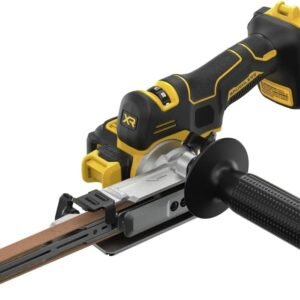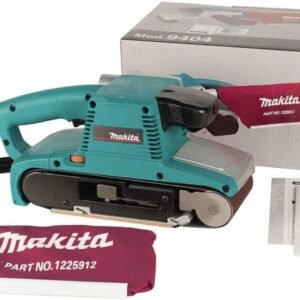Makita 9031 Belt Sander Review Exploring Precision and Power in Compact Sanding Tools
Makita 9031 Belt Sander Review Exploring Precision and Power in Compact Sanding Tools
- Compact and lightweight design (4.6 lbs.) makes it easy to maneuver in tight spaces for detailed sanding tasks.
- Variable speed control dial allows adjusting belt speed from 656 to 3,280 ft./min., providing flexibility for different materials and finishes.
- Multi-position side handle enhances comfort and control during extended use, reducing user fatigue.
- The lock-on button enables continuous operation, making longer projects less tiring and more efficient.
As an Amazon Associate I earn from qualifying purchases.
Description
Compact Design That Fits Tight Spaces
Testing the Makita 9031 1-1/8″ x 21″ Belt Sander in my workshop revealed just how compact and lightweight this tool really is. Weighing only 4.6 pounds, it maneuvers effortlessly around tight corners and confined spaces, which is a blessing when dealing with intricate furniture making or fine carpentry. The narrow 1-1/8 inch belt combined with the exposed front pulley makes sanding irregular shapes surprisingly smooth. I found it particularly handy while refinishing a vintage chair with curved edges; the sander hugged the contours better than bulkier models I’ve used before. If you’re like me, struggling to get into those nooks and crannies, this feature alone is worth noting.
Precise Control with Variable Speed
One of the standout features is the electronic speed control dial, allowing me to adjust the belt speed between 656 and 3,280 feet per minute. This range gave me the flexibility to move from delicate sanding on softwoods to more aggressive material removal on metal surfaces. I remember sanding down some rough cedar planks and then switching seamlessly to smoothing fiberglass without needing to swap tools. The constant speed under load is no gimmick either; even under pressure, the motor maintained steady performance, which really impressed me. The lock-on button for continuous use made longer sessions less tiring, too.
Comfortable Handling and User-Friendly Setup
The multi-position side handle on this sander is not just a gimmick—it genuinely enhances grip and comfort. I found myself switching hand positions frequently depending on the angle and surface I was working on, and this adaptability reduced fatigue during extended use. Another thoughtful touch is the dust collector connection, which helped keep my workspace cleaner than usual. Although the sander isn’t sold with a dust extractor, the ability to hook one up means less cleanup later, which my wife greatly appreciated after I took over the garage workshop.
Positive Features That Matter
- Versatile for use on wood, metal, and fiberglass materials
- Ideal for professionals like woodworkers, finish carpenters, and welders
- Smooth operation thanks to ball and needle bearing construction
- Lock-on button enables continuous sanding without hand strain
The combination of these features made the sander a reliable companion for a variety of projects. It wasn’t just about raw power; the tool felt thoughtfully designed for precision and ease.
Areas of Concern
No product is perfect, and this one has its quirks. For starters, the 5 AMP motor, while efficient, sometimes struggled a bit with very dense hardwoods, especially when pushing hard. It’s not a heavy-duty industrial beast, so expecting it to tackle massive jobs without slowing down is unrealistic. Also, the belt replacement process isn’t the quickest I’ve encountered; it requires a bit of fiddling to get the tension right, which can be frustrating if you’re switching belts frequently.
Another point worth mentioning is the noise level. The sander runs at a fairly high decibel, which means wearing hearing protection is a must in confined spaces. My kids, who watched me work on a new bookshelf, definitely noticed the racket and insisted I take breaks. Lastly, the power cord length felt a bit limiting at times, especially in larger work areas without easy access to outlets.
Competitors in the Belt Sander Market
Comparing this sander to similar models like the Bosch 1274DVS and the DeWalt DWP352VS, the Makita stands out for its compact design and maneuverability. The Bosch offers slightly better motor power and a more refined dust collection system, but it’s bulkier and harder to control in tight spaces. DeWalt’s model shines with an adjustable tracking system and ergonomic grip, but the belt width is larger, making it less suitable for detailed work.
Where the Makita edges ahead is in the variable speed range and lightweight build, which I found invaluable for delicate tasks. However, if dust collection and quieter operation are your priorities, the Bosch might be a better fit. The DeWalt sits somewhere in the middle but leans towards heavier-duty applications rather than fine finishing.
Price to Quality Ratio
This sander offers a solid value proposition for those who need a tool that balances precision and power without breaking the bank. While it’s not the cheapest belt sander available, the build quality and thoughtful features justify the investment for hobbyists and professionals alike. Considering the durable ball bearing construction and the versatility across multiple materials, I found it to be worth every penny spent.
If budget constraints are tight, you might find cheaper options with similar specs, but they often lack the finesse and durability that this sander delivers. For me, the peace of mind knowing the tool can handle everything from woodworking to metal smoothing without overheating or stalling adds significant value.
Performance on Different Materials
Testing the sander across various surfaces was an eye-opener. Its ability to handle wood, metal, and fiberglass makes it a versatile addition to any workshop. Sanding softwood was smooth and even, while metal surfaces required a slower speed setting to avoid scorching. Fiberglass work benefited from the narrow belt, allowing me to follow curves and edges with precision.
The sander’s ball and needle bearing construction ensures quieter, smoother operation, which I noticed especially when transitioning between materials. It’s a subtle difference, but it reduces vibration and hand fatigue, which is welcome during longer projects. However, for very heavy-duty sanding, a more powerful model might be necessary.
Practical Experience and User Impressions
My coworkers borrowed this sander for their fine carpentry tasks and came back with thumbs up, praising its multi-position handle and ease of use. My nephew, who’s just getting into woodworking, found it less intimidating to handle compared to larger sanders. Dust collection was a big hit with everyone, especially those sensitive to particles.
On the flip side, some users mentioned that the belt tension mechanism could use improvement, echoing my experience with occasional belt slippage if not properly secured. Overall, it’s a tool that feels like it was designed with the end user in mind, balancing performance and comfort.
The Makita 9031 offers a unique blend of precision, power, and portability that’s hard to beat for detailed sanding projects. Its thoughtful features deliver a comfortable and efficient sanding experience, though it does have a few limitations worth considering before making a purchase.
Additional information
| Brand | Makita |
|---|---|
| Product Dimensions | 5.89"L x 2.63"W x 1.39"H |
| Grit Type | Fine |
| Voltage | 100 Volts |
| Power Source | Corded Electric |
| AC Adapter Current | 5 Amps |
| Grit Number | 1 |
| Maximum Rotational Speed | 3.28E+3 Feet Per Second |
| UPC | 718472146491 737946468617 094703505047 088381016254 |
| Global Trade Identification Number | 00088381016254 |
| Manufacturer | Makita |
| Part Number | 9031 |
| Item Weight | 4.6 pounds |
| Item model number | 9031 |
| Is Discontinued By Manufacturer | No |
| Style | Music |
| Wattage | 550 |
| Item Package Quantity | 1 |
| Number Of Pieces | 1 |
| Included Components | No |
| Batteries Included | No |
| Batteries Required | No |
| Warranty Description | Limited 1 year |
| National Stock Number | 5130-01-397-8920 |
| Date First Available | November 21, 2000 |


